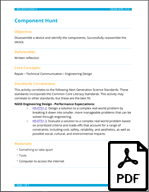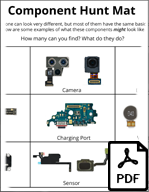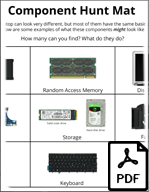
Component Hunt
Component Hunt
Objective:
Disassemble a device and identify the components. Successfully reassemble the device.
Deliverable:
Written reflection
Core Concepts:
Repair
Technical Communication
Engineering Design
Standards Correlations:
This activity correlates to the following Next Generation Science Standards. These standards incorporate the Common Core Literacy Standards. This activity may correlate to other standards, but these are the best fit:
NGSS Engineering Design - Performance Expectations:
HS-ETS1-2. Design a solution to a complex real-world problem by breaking it down into smaller, more manageable problems that can be solved through engineering.
HS-ETS1-3. Evaluate a solution to a complex real-world problem based on prioritized criteria and trade-offs that account for a range of constraints, including cost, safety, reliability, and aesthetics, as well as possible social, cultural, and environmental impacts.
Materials:
Something to take apart
For ideas and safety concerns, see K-12 Safety Tips
Tools
Computer to access the internet
Procedures:
Activity 1: Understanding Repair
As a class, brainstorm what repair means. Have students talk as a class (or with their families) and write a reflection on the following questions:
What is broken in your life?
What things have been broken in the home? Why did they break?
What things do you think are easy to fix? What things are difficult to fix? Why?
What are some possible trade-offs with making things repairable?
Activity 2: Component Hunt
Come up with a list of components for students to find in their devices. Students can all use similar or different types of devices. It can be instructive to show the differences in the same component across many different devices. For example, students can compare the similarities and differences between the motherboards in cell phones, laptops, and game consoles. If you aren’t sure what components to look for, we have printable mats that have many common components in phones and laptops. Be sure to have students reassemble their devices when they are finished. It is just as important for students to learn that they can successfully take apart and reassemble devices as it is for them to learn about the components that make up the device.
Pick one physical item to take apart and evaluate.
Disassemble the device, paying close attention and taking notes as to how it comes apart.
Identify the components and match them to the component hunt mat.
Reassemble the device.
Write a reflection on what you found inside your device.
Discussion Topics
What did you find in your device?
Did the components look like you expected them to look? Why or why not?
What sort of tools did you need to take the device apart?
Was taking the device apart easy or hard? Why? What about putting it back together?
Do you think the device was designed to be repaired? Why or why not?
Other Resources
edu.ifixit.com/k12: iFixit’s K-12 education site
iFixit.com/teardown: Examples of teardowns that have repairability scores
ifixit.com/Device/Electronics_Skills: Tips and tricks to working on electronics
Screwdriver Best Practices: Tips and tricks to properly use screwdrivers
Recognizing and Disconnecting Cable Connectors: Explains how to identify and disconnect the most common connectors in electronics
How to Remove Stripped Screws: Accidents happen, and this handy guide demonstrates how to remove stripped screws
Identifying Major Electronic Components: A more comprehensive explanation of major electronic components


